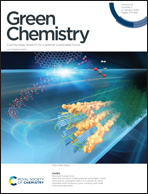Efficient reductive amination of HMF with well dispersed Pd nanoparticles immobilized in a porous MOF/polymer composite†
Abstract
Aminated derivatives of 5-hydroxymethylfurfural (HMF) and furfural are critical intermediates for the pharmaceutical industry. The state-of-the-art catalysts currently used for these syntheses are mostly homogeneous in nature, motivating the design of recyclable, heterogeneous catalytic systems. As such, the present study illustrates a new method for the design of metal–organic framework (MOF)/polymer composites containing well-defined metal nanoparticles in a sustainable way. One such palladium functionalized MOF/polymer composite is then employed in the reductive amination of HMF under mild conditions. The catalyst shows excellent activity, including a high TON/TOF (h−1) of 604.8/302.4 and ∼94% amine yield, which is maintained over a larger number of reaction cycles (up to 15) when compared to several state-of-the-art materials, such as a commercial Pd/C (3 cycles). It is thought that the origin of the improved catalyst recyclability is due to the added polymer, poly-para-phenylenediamine (PpPDA), which helps to prevent the aggregation and leaching of the palladium nanoparticles. The synthetic approach is further extended to design other potential catalysts with different metallic nanoparticles (NPs).



 Please wait while we load your content...
Please wait while we load your content...